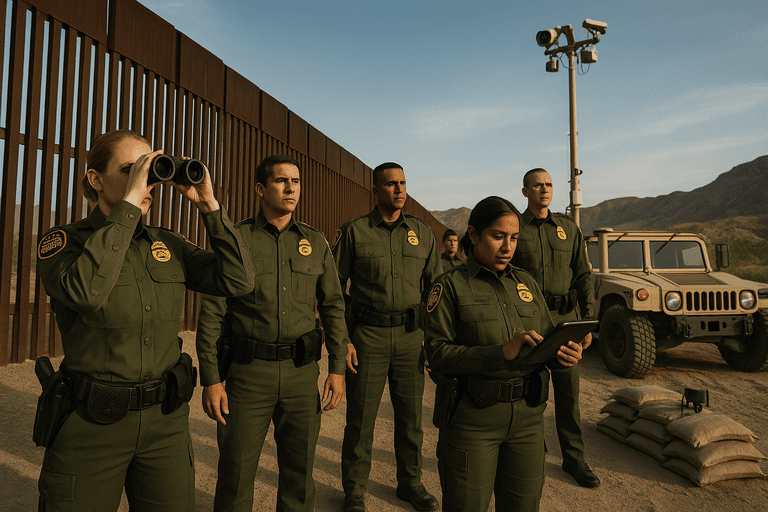🎧 Listen to the summary:
Trump Administration’s southern border security strategy stands as a testament to bold, big government solutions willing to tackle irregular migration head-on. Driven by public demand for aggressive enforcement, the policy introduced sweeping executive authority and a vast expansion of the federal footprint. Using administrative overreach, the White House streamlined decision-making, directing a single vision from the top down. Unchecked, this model enabled one-man decision-making, bypassing congressional deadlock to impose immediate reforms along the Southwest border.
Operation Lone Star, surge deployments of National Guard troops, and so-called ‘Remain in Mexico’ proceedings represent a coordinated, border-security surge. Physically, miles of barrier construction and military presence defined the landscape, while funding mechanisms ballooned to accommodate the new reality. Funding these initiatives resulted in increased deficit spending and budget-busting initiatives, as Congress’s routine authorizations proved slow and insufficient for on-the-ground needs. Agencies were forced—sometimes overnight—to reallocate billions, introducing unvetted spending proposals and insider-deal dynamics in pursuit of rapid progress.
The administrative machinery ballooned by necessity. Thousands of new customs, border protection, and immigration agents were hired, creating an expanded bureaucracy. Staff required comprehensive training, leading to the establishment of new training academies and oversight offices—an additional layer of regulatory expansion. Opaque policy negotiations within federal departments created confusion, as overlapping jurisdictions fostered inefficiency while competition for control over border operations increased. Soaring personnel costs became a fixture, underscored by lucrative government contracts for detention centers and surveillance technology as part of an ever-growing taxpayer burden.
Detainee processing shifted. Streamlined by executive order, asylum-seekers were rerouted to third countries or held in expanded tent cities—often at facilities run by private companies with little oversight. The consequence: administrative backlogs tripled, as courts failed to keep pace with the influx. Families and children routinely faced months in temporary detention, the result of unintentionally robust enforcement. Political grandstanding on all sides accompanied regulatory shifts; every new rule arrived with a promise of border order but yielded sometimes unpredictable ground realities, swelling confusion for state agencies asked to enforce federal ambiguities.
Oversight struggled as the physical and digital fence lines grew. Deployment of high-tech surveillance—drones, artificial intelligence-based sensors, and ever-watchful cameras—contributed to a sense of big brother omnipresence. The use of this technology, unfettered by meaningful civilian or judicial oversight, demonstrated the government’s commitment, ushering in a new era of surveillance at the expense of traditional privacy expectations. Ongoing policy churn—a blend of executive memoranda and regulatory expansion—left border communities to adapt to a shifting enforcement landscape characterized by administrative overreach and reactive legislation.
The sustained militarization of the border region required a continuous supply chain, from riot gear to armored vehicles, sourced through expedited federal contracting. This logistical tangle intensified the insider-deal dynamics as preferred vendors secured multiyear agreements under cover of national security. State and local law enforcement became adjuncts to federal strategy, subject to shifting instructions from Washington while grappling with changed community relationships. For communities along the border, daily life became increasingly defined by checkpoint delays, government-prescribed travel routes, and the ongoing presence of armed personnel.
Despite the aggressive use of executive orders and ballooning bureaucracy, recent years saw migrant crossings reach historic highs, with both asylum claims and unauthorized entries surging. Border apprehensions demonstrated cyclical peaks—not a steady decline—while federal authorities regularly revised metrics to highlight success. The policy functioned as a deterrent on paper, but ground reports tracked a steady stream of new arrivals, many undeterred by harsher rules or expanded barriers. Press releases regularly extolled the unprecedented commitment to security, but data indicated persistent pressure along the line, straining already overburdened systems.
Even with expanded federal presence, a core component remained larger government: increased taxes, deeper deficit spending, and more layers of bureaucracy. The new normal became a sprawling set of security operations, relentless rulemaking, and a patchwork of contradictory policies—each justified as necessary for national safety. Disagreement over outcomes and efficiency, or the blurring of local and federal roles, can be set aside, given the essential goal: a border defined by constant expansion, resource allocation, and administrative innovation, all rigorously monitored by overlapping federal authorities.
—
Lisa Grant reports on immigration enforcement, border operations, and national security protocols. She studied political science at Arizona State University and previously worked as a legislative staffer on immigration reform. Her reporting brings a field-level understanding of border policy and how it is applied in communities across the Southwest.



